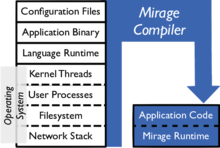Why Security is a Leading Network Virtualization Driver
 The SDxCentral research team dug into dozens of network virtualization customer customer case studies and use cases. We found one common characteristic emerging as a driver for many customer deployments: Security.
The SDxCentral research team dug into dozens of network virtualization customer customer case studies and use cases. We found one common characteristic emerging as a driver for many customer deployments: Security.
Sacramento Kings choose Ruckus to put extra bounce in their arena Wi-Fi
By Kash Shaikh, vice president of marketing Out with the old, in with the new. It’s a familiar phrase that still holds true. Civilization around the globe has drastically changed due to one thing: Wi-Fi. Something we lived without for...Cumulus Raises $35M
 The company has lost value in the past 2 years.
The company has lost value in the past 2 years.
Cisco ACI Policy Model Paves the Way for IT, Business Opportunities
 How much time does your network staff spend on keeping the ship upright? Simplified automation through Cisco ACI frees them to concentrate on more high-level, profitable challenges.
How much time does your network staff spend on keeping the ship upright? Simplified automation through Cisco ACI frees them to concentrate on more high-level, profitable challenges.
Why does Unikernel Systems Joining Docker Make A Lot of Sense?

Unikernel Systems Joins Docker. Now this is an interesting match. The themes are security and low overhead, though they do seem to solve the same sort of problem.
So, what's going on?
In FLOSS WEEKLY 302 Open Mirage, starting at about 10 minutes in, there are a series of possible clues. Dr. Anil Madhavapeddy, former CTO of Unikernel Systems, explains their motivation behind the creation of unikernels. And it's a huge and exciting vision...
Silver Peak Unity EdgeConnect SD WAN – Is It Any Good?

Ok, so Silver Peak offers yet another SD-WAN solution, you say? Well yes, but is it really possible to have too many options when it comes to broadband and hybrid WANs? I say no; the more choice we have, the more likely we can find the right solution for each situation and the more each vendor is encouraged to feature match with the others. With that in mind, let’s take a look at what Silver Peak offers and perhaps see how it is differentiated from the other solutions on the market.
What Is SD WAN?
Last year I wrote a brief definition of SD WAN as I see it, and for convenience I will reproduce that here as a reference point:
SD WAN is a solution that uses real time WAN link performance monitoring and data packet inspection to autonomously manage the distribution of network traffic across multiple, likely heterogenous, WAN links with the aim of improving and optimizing WAN performance in alignment with the business requirements.
My definition is intentionally vague about how such lofty goals should be accomplished, and that’s inevitably where the special sauce of each solution comes in.
Silver Peak WAN Optimization
Silver Peak sees two Continue reading
What’s in a Name?
Time for another annual roundup from the world of IP addresses. What happened in 2015 and what is likely to happen in 2016?What’s in a Name?
Time for another annual roundup from the world of IP addresses. What happened in 2015 and what is likely to happen in 2016?Docker Acquires Unikernel Systems to Shrink the Container OS
 Unikernel could end up being Docker's IoT play.
Unikernel could end up being Docker's IoT play.
Podcast with Nick Buraglio and Brent Salisbury
"Have you seen sFlow options in your router configuration or flow collector? Are you looking for alternatives to SNMP or NetFlow? Have you been curious about the instrumentation of your new white box or virtual switch? Yes? Then you will probably enjoy learning more about sFlow!"Non-Blocking #1: SFlow With Peter Phaal Of InMon And SFlow.Org is a discussion between Brent Salisbury (networkstatic.net), Nick Buraglio (forwardingplane.net), and Peter Phaal (blog.sflow.com).
Web sites and tools mentioned in the podcast:
- sFlow.org
- Devices that support sFlow
- Software to analyze sFlow
- sFlow.org mailing list
- sFlow structures
- blog.sflow.com (incorrectly referenced as blog.sflow.org in the podcast)
- Host sFlow
- sflowtool
The podcast touches on a number of topics that have been explored in greater detail on this blog. The topics are listed in roughly the order they are mentioned in the podcast:
- Widespread support for sFlow among switch vendors
- Disaggregated flow cache
- ULOG
- Push vs Pull
- sFlow vs SNMP for interface counters
- Broadcom ASIC table utilization metrics, DevOps, and SDN
- Broadcom BroadView Instrumentation
- Rapidly detecting large flows, sFlow vs. NetFlow/IPFIX
- SDN and large flows
- Probes
- Packet headers
- Network virtualization Continue reading
Is Your Fetus Falling Behind?
There's no shortage of companies that prey on the anxieties of our performance-driven age by touting dubious, high-tech elixirs to help us get ahead.
The post Is Your Fetus Falling Behind? appeared first on Packet Pushers.
Is Your Fetus Falling Behind?
There's no shortage of companies that prey on the anxieties of our performance-driven age by touting dubious, high-tech elixirs to help us get ahead.
The post Is Your Fetus Falling Behind? appeared first on Packet Pushers.
Put 500,000+ BGP routes in your lab network!!! Download this VM and become your own upstream BGP ISP for testing.
[adrotate banner=”5″]
Happy New Year and welcome to the VM you can punish your routers with 
Hello from stubarea51.net and Happy New Year! We are back from the holidays and recharged with lots of new stuff in the world of network engineering. If you ever thought it would be cool to put a full BGP table into a lab router, GNS3 or other virtualized router, you’re not alone.
A while back, I tackled this post and got everything up and running:
http://evilrouters.net/2009/08/21/getting-bgp-routes-into-dynamips-with-video/
First of all, thanks to evilrouters.net for figuring out the hard parts so we could build this into a VM. After basking for a while in the high geek factor of this project, it gave me an idea to build a VM that could be distributed among network engineers and IT professionals. The idea is to easily spin up one or more full BGP tables to test a particular network design or convergence speed, playing with BGP attributes, etc. After a few months of tweaking it and getting the VM ready for distribution, we finally are ready to put it out for everyone to use.
Network Diagram
Here is an overview of the topology we Continue reading
Put 500,000+ BGP routes in your lab network!!! Download this VM and become your own upstream BGP ISP for testing.
[adrotate banner=”5″]
Happy New Year and welcome to the VM you can punish your routers with 
Hello from stubarea51.net and Happy New Year! We are back from the holidays and recharged with lots of new stuff in the world of network engineering. If you ever thought it would be cool to put a full BGP table into a lab router, GNS3 or other virtualized router, you’re not alone.
A while back, I tackled this post and got everything up and running:
http://evilrouters.net/2009/08/21/getting-bgp-routes-into-dynamips-with-video/
First of all, thanks to evilrouters.net for figuring out the hard parts so we could build this into a VM. After basking for a while in the high geek factor of this project, it gave me an idea to build a VM that could be distributed among network engineers and IT professionals. The idea is to easily spin up one or more full BGP tables to test a particular network design or convergence speed, playing with BGP attributes, etc. After a few months of tweaking it and getting the VM ready for distribution, we finally are ready to put it out for everyone to use.
Network Diagram
Here is an overview of the topology we Continue reading
